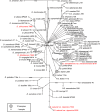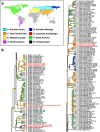Non-radiative origin for alpine endemics of Draba (Brassicaceae) in the central mountains of the Japanese Archipelago
- PMID: 40299227
- PMCID: PMC12238178
- DOI: 10.1007/s10265-025-01643-7
Non-radiative origin for alpine endemics of Draba (Brassicaceae) in the central mountains of the Japanese Archipelago
Abstract
Diversity of endemic species may result from two evolutionary processes: in-situ diversification (radiation) or phylogenetically independent divergences (non-radiation). To explore the evolutionary history of endemic-rich alpine flora in the Japanese Archipelago, we investigated the phylogenetic relationships of four endemic taxa of Draba (Brassicaceae) from the high mountains of central Honshu: D. kitadakensis, D. sachalinensis var. shinanomontana, D. sakuraii var. nipponica, and D. shiroumana. Using molecular phylogenetic analyses on plastid trnL-F and nuclear ITS sequence of 157 taxa, we found that the four taxa endemic to central Honshu did not form a monophyletic group and diverged from at least two evolutionary independent lineages. Moreover, ancestral area reconstruction further revealed that some of their ancestral species may have originated from different geographical regions. These findings indicate that the endemic Draba in central Honshu diverged through non-radiative evolutionary origin. Our study suggests that the richness of endemic species in the alpine zone of the Japanese Archipelago is associated with multiple sources with high species diversity located in nearby geographical regions.
Keywords: Alpine plants; Beringia; BioGeoBEARS; Biogeography; East-Central Asia; Phylogeography.
© 2025. The Author(s).
Conflict of interest statement
Declarations. Conflict of interest: Authors have no conflict of interest to declare.
Figures




Similar articles
-
Population Genetics of the Asian Parti-Colored Bat, Vespertilio sinensis: Insights into Seasonal Migration in the Japanese Archipelago.Zoolog Sci. 2025 Jun;42(3):270-278. doi: 10.2108/zs230119. Zoolog Sci. 2025. PMID: 40638152
-
Factors that influence parents' and informal caregivers' views and practices regarding routine childhood vaccination: a qualitative evidence synthesis.Cochrane Database Syst Rev. 2021 Oct 27;10(10):CD013265. doi: 10.1002/14651858.CD013265.pub2. Cochrane Database Syst Rev. 2021. PMID: 34706066 Free PMC article.
-
Inferring complex evolutionary history of the closely related East Asian wild roses in Rosa sect. Synstylae (Rosaceae) based on genomic evidence from conserved orthologues.Ann Bot. 2025 Feb 19;135(3):417-436. doi: 10.1093/aob/mcae170. Ann Bot. 2025. PMID: 39292610
-
Temperature dependence of liverwort diversification reveals a cool origin and hot hotspots.Sci Rep. 2025 Jan 25;15(1):3225. doi: 10.1038/s41598-025-87206-1. Sci Rep. 2025. PMID: 39863681 Free PMC article.
-
Systemic pharmacological treatments for chronic plaque psoriasis: a network meta-analysis.Cochrane Database Syst Rev. 2021 Apr 19;4(4):CD011535. doi: 10.1002/14651858.CD011535.pub4. Cochrane Database Syst Rev. 2021. Update in: Cochrane Database Syst Rev. 2022 May 23;5:CD011535. doi: 10.1002/14651858.CD011535.pub5. PMID: 33871055 Free PMC article. Updated.
References
-
- Abbott RJ, Brochmann C (2003) History and evolution of the arctic flora: in the footsteps of Eric Hultén. Mol Ecol 12:299–313. 10.1046/j.1365-294X.2003.01731.x - PubMed
-
- Akaike H (1974) A new look at the statistical model identification. IEEE Trans Autom Control 19:716–723. 10.1109/TAC.1974.1100705
-
- Blanco-Gavaldà C, Galbany-Casals M, Susanna A, Andrés-Sánchez S, Bayer RJ, Brochmann C, Cron GV, Bergh NG, Garcia-Jacas N, Gizaw A, Kandziora M, Kolář F, López-Alvarado J, Leliaert F, Letsara R, Moreyra LD, Razafimandimbison SG, Schmickl R, Roquet C (2023) Repeatedly northwards and upwards: Southern African grasslands fuel the colonization of the African sky islands in Helichrysum (Compositae). Plants 12:2213. 10.3390/plants12112213 - PMC - PubMed
-
- Camacho GP, Loss AC, Fisher BL, Blaimer BB (2021) Spatial phylogenomics of acrobat ants in Madagascar—mountains function as cradles for recent diversity and endemism. J Biogeogr 48:1706–1719. 10.1111/jbi.14107
MeSH terms
Substances
Grants and funding
LinkOut - more resources
Full Text Sources

